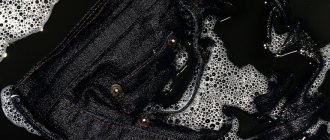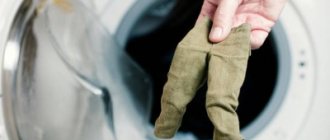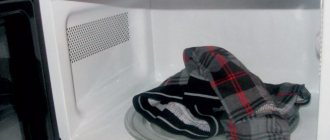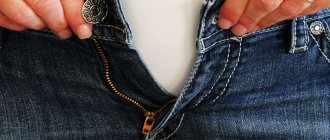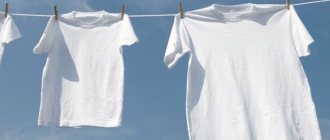Jeans are a popular wardrobe item. They are practical, so you can wear them at any time of the year. However, sometimes these versatile pants can cause serious frustration.
This happens after washing, when improper care of the product provokes their shrinkage. To avoid such a situation, you need to know certain rules.
Let's take a closer look at whether jeans shrink after washing, especially if you wash them in very hot water (90 degrees).
How to determine in advance whether your pants will fit?
It is impossible to say 100% that pants will shrink after washing. However, the risks increase in the following cases:
- The fabric contains a large percentage of cotton. Products containing synthetic fibers are less likely to shrink.
- Suitable for washing at high temperatures.
- After washing, it is planned to subject the pants to an automatic spin cycle.
- Stretch jeans do not shrink. These things stretch great.
The more intensive processing the jeans undergo, the more likely they are to shrink. Read about the rules for washing jeans here.
Features of denim fabrics
Jeans began their march around the planet in the middle of the 19th century as an item of clothing for a working man. Both pants and other products, shirts, jackets, were made of dense, coarse cotton, which gave maximum wear resistance and durability. Over time, jeans took over the world, moving into the category of casual wear. The global increase in importance is driven by developments that improve the appearance and functionality of fabrics.
The following types of denim fabrics are distinguished:
- Denim. You will have to pay a decent amount for jeans made from real denim. But the price is worth it. They contain exclusively natural, high-quality raw materials. A distinctive feature is the color: blue on the front and white on the back. They are not afraid of high temperatures - washing up to 90 degrees is acceptable.
- Jean. If you compare denim and gin, they are the exact opposite of each other. Gin is distinguished by its availability, which, unfortunately, comes with low quality. The coloring is identical for both sides. A special feature is considered to be imaginary shrinkage. Jeans washed in hot water visually shrink in both volume and length. In fact: the fabric will shrink only temporarily. One of the advantages, perhaps, is that along with the size, the softness lost during shrinkage will return.
- Stretch. Skinny jeans that embrace every curve of the body with a gentle embrace are sewn from an elastic material called “stretch”. To obtain the existing result, according to the technology, elastic threads are added to coarse fabrics, such as denim. The result is an ideal symbiosis that gives a wonderful aesthetic appearance and a comfortable feeling when worn. The aesthetics of the product are undermined as soon as the jeans begin to stretch, which cannot be avoided with constant, intense wear. Hand washing using hot water and natural drying will correct the situation.
- Chambray. Of all denim fabrics, chambry is characterized by its fragility: things made from the fabric wear out quickly and tear easily. After washing in hot water or boiling, they shrink significantly. This is due to the fact that the density of chambrie is much less than that of high-quality denim. But it is precisely this indicator that makes the fabric an ideal material for things for the summer.
The composition of the fabric gives jeans the ability to stretch and shrink.
Tips to avoid shrinkage
To prevent pants from becoming 1-2 sizes smaller after washing, you need to adhere to the following recommendations:
- Wash the item as little as possible. Frequent contact with water causes fabric fibers to shrink.
- Avoid temperature changes. You should not rinse your pants first in hot and then in cold water. It should always remain warm.
- Do not wash the product in boiling water. The higher the degree, the stronger the shrinkage of the fabric.
- Do not wring or twist the item after hand washing. When loading the product into the drum of the washing machine, the spin cycle must be turned off.
- Do not dry jeans folded. They should be straightened.
- Do not place the product near heat sources, for example, near a radiator.
- Do not resort to express drying methods.
- Use fabric softener when washing. It makes the fibers of the fabric soft and elastic, so they do not shrink or shrink.
It will not be possible to completely avoid shrinkage of jeans, since any wetting and subsequent drying of the fabric leads to compression of the fibers.
However, if all care rules are followed, jeans will wear out quickly and shrinkage will be negligible.
Using a spray bottle (without getting completely wet)
This method is similar to the previous one, but does not involve completely wetting the fabric. Suitable for cold seasons and cool rooms.
It is enough to spray the part of the product that needs to be stretched with a spray bottle until it is completely wet. The water should not be too hot. And stretch the fabric for some time in the place where the pants are too small. At the end of the procedure, leave to dry. Try repeating the steps if they did not bring the desired result. But if the jeans are too worn and torn, then you should not stretch them using this method.
Worth knowing:
- To quickly and easily stretch the product in the buttocks and waistband area, you need to pull out the seam that is under the waistband and “goes” from the back to the front of the jeans.
- To increase the length, you need to wet the area from the knees to the very bottom.
- If you need to stretch the belt, then the zippers and buttons should be undone.
- Do not pull on pockets or fittings.
What if I wash them in hot water (90 degrees)?
After washing in hot water, jeans will definitely shrink. The higher its temperature, the greater the degree of shrinkage:
- washing at 50-60 degrees shrinks by 0.5-1 size;
- washing at 60-70 degrees reduces jeans by 1-1.5 sizes;
- washing at temperatures of 80 degrees and above leads to shrinkage by 2 sizes;
- The contraction of fabric fibers is enhanced by alternating treatment with hot and cold water.
The values given are average values. The exact numbers depend on the composition of the material, the characteristics of washing and drying the product.
If your jeans have become stretched during wear, this can be corrected by boiling.
Do it as follows:
- Hot water is poured into an enamel basin and brought to a boil.
- Jeans are soaked in boiling water.
- If they float, they are immersed back in using wooden tongs.
- After 5 minutes, turn off the water and leave to cool. To make this process happen as slowly as possible, the basin is covered with a lid.
- When the water has cooled, the pants are taken out and sent to dry.
Boiling colored or black jeans will cause pigment loss. Therefore, only white products can be subjected to this treatment.
Do jeans shrink after washing?
When buying jeans you like, you always want to know in advance how much they will shrink (if at all).
This question is especially of concern to those who purchase a treasured pair in an online store. And even if all the required dimensions of the product are known down to the millimeter, the relevance of the issue remains. The denim used to make trousers is a cotton fabric of fairly high rigidity, and has not undergone any pre-treatment. It was also not soaked, so there is always the possibility of significant shrinkage. What is shrinkage, and what values can it take? Cotton threads have such a structure that, as a result of external influences, they change their density and rigidity, which, in turn, leads to a decrease in the linear dimensions of the entire product.
Modern technologies have taken into account this specificity of denim fabric, so its processing has become almost mandatory. After appropriate manipulations, denim no longer changes its size, and the product, accordingly, retains the original parameters indicated on the label.
Everything would be good and convenient, but for several seasons in a row, products made from “primitive” jeans, which were not processed in any way, began to appear on store shelves (and on the pages of online catalogues). So should you panic when you find out that you bought just such a pair?
No no and one more time no. Before the first use, you must finally make sure that the jeans are made from virgin denim. This will be indicated by the RAW or Unwashed marking on the label. Every store that sells raw cotton has special shrinkage charts that can easily guide and indicate how many sizes jeans will shrink after washing and wearing. This table shows two sizes: initial and after shrinkage.
Features of raw denim trousers
When planning to buy jeans made from virgin material, you need to initially find out one important nuance. Some manufacturers indicate the initial parameters of the product in the dimensions, and the buyer must determine for himself the amount of the required stock; other brands, on the contrary, indicate the size of trousers after possible shrinkage. Moreover, the first option can be found much more often, so you should be extremely careful and add at least another 3 cm to the size of the belt and the length of the product. Then the purchased jeans will fit perfectly.
All this information can be obtained from the “Product Care” section, which is usually available in reputable online stores. If you couldn’t find such information, you shouldn’t rush into making a purchase, but it’s better to first contact an online consultant and clarify everything with him.
Compromise option: “shrinkage with return”
In order not to be too categorical and not to create unpleasant situations for their customers, many manufacturers have made a compromise and created something in between the described options. The resulting jeans are marked RAW SANFORIZED on the label, which means that the fabric has gone through the appropriate stages of sanforization, the essence of which is sequential soaking, steaming and stretching with load. Then the jeans are dried and in appearance are no different from the original material, but their shrinkage is minimal. It appears only immediately after washing, and after an hour of wearing the jeans return to their previous parameters.
Jeans processed in this way are the most popular segment among buyers, since the risk of buying the wrong size is reduced to zero.
For those who truly love raw denim
If the desire to buy trousers made from “real” denim cannot be suppressed by any “counterfeits”, then the shrinking procedure will need to be carried out on your own. To ensure that you have enough knowledge and the result is what is expected, you should use a few tips.
1. Required components:
– a large container in which jeans will fit “full-length” (you can use a bathtub, if you don’t mind);
– water heated to a temperature of at least 60 degrees Celsius;
- a weight that will prevent the jeans from floating to the surface (plastic bottles filled with water are perfect).
2. Jeans must be carefully placed at the bottom of the container so that there are no folds or creases on them, and pressed down with a weight. They should soak for at least 4 hours, and there is no need to panic if the water becomes colored. This is absolutely normal. Then the jeans are taken out and hung in such a way that water flows freely down them.
3. If after shrinking you cannot fit into your jeans (they have become tight in the waistband), then you can soak the waistband for another hour and then dry it using special spacers. They will give the width the required size.
Caring for denim pants
Treated denim can be washed in a washing machine, but only use medium temperatures. Products made from untreated material prefer delicate modes without the addition of any aggressive reagents. It is also better to choose a soft powder.
With proper care, even the most “favorite” jeans, worn more often than others, will last more than five years and will not lose their characteristics.
My jeans shrunk after washing, what should I do? There is an exit!
Perhaps today you cannot meet a single person who does not have jeans in his wardrobe. These trousers are practical, comfortable, go with any outfit and have not gone out of fashion for half a century. However, many people are concerned about the question: do jeans shrink after washing and what to do about this problem.
We can find the answer to the first question by referring to the product label:
- The “Shrink to fit” marking indicates that these jeans shrink greatly once, after the very first wash, and no longer change their shape. If you like these jeans in a store, it’s best to buy them a size larger in advance.
- If you purchased elastic jeans, the unpleasant situation with shrinkage simply will not arise. Rubber elastane threads woven into the fabric will not allow the product to lose its shape.
- classic jeans are usually made from denim, which, like most cotton fabrics, tends to deform after washing. In addition, the material is quite rough and hard, making it difficult to work with. Therefore, you will have to be as careful as possible with such products.
- Also, the features of further operation depend on whether the jeans are boiled or not. “Varenki” are extremely unpretentious and practically do not change their shape after washing.
How to wash so they don't shrink?
To prevent jeans from shrinking during washing, you need to care for them properly. Preference should be given to the manual cleaning method.
The following recommendations must be followed:
- wash pants in cool water, its temperature should not exceed 30 degrees;
- When removing dirt, do not rub or crush the product;
- wash jeans straightened, soaking them in the bathtub;
- Do not wring out the fabric, let it dry naturally.
These simple rules will help you avoid fabric shrinkage. If after washing the item becomes smaller, there is no need to despair.
Most often, after 2-3 hours of active wear, the jeans stretch and take their previous shape. Read about other ways to return jeans to their previous size here.
If the fabric becomes rough after contact with water, you can correct the situation using a steamer. They iron the item, paying special attention to the seams, pockets and waistband. After cooling, the jeans will become softer and more comfortable to wear.
We pull in separate places
If jeans need to be stretched locally, then there is no point in getting them completely wet.
In the calves
If the trousers need to be made looser in the calves, the trouser legs are moistened below the knee line and stretched with your hands or a hot iron.
In the hips
In this area, the material is stretched with an expander or with your own body, putting the wet product on yourself and doing a few squats to be sure.
In the belt
The belt lends itself well to stretching with an expander when it is left until the fabric dries completely. It is also easy to steam, stretch with your hands or with your own volumes.
How to shrink the product?
To make the product smaller by 1-2 sizes, it must be dried properly . The pants are laid out on a flat surface, covered with a terry towel.
You need to smooth them out with your hands, giving them the correct shape. Being in a horizontal position, the fibers will not shrink during the drying process.
Methods for shrinking denim:
To ensure that denim shrinks, it is recommended to wash the item in an automatic washing machine. Such intensive processing will lead to compression of the fibers and their reduction by 1-2 sizes.- Washing in boiling water. The higher the water temperature, the greater the shrinkage. If necessary, the pants can be boiled. Adding a soap solution enhances the effect.
- Wash and spin at high speeds. To do this, use the “intensive wash” program. The speed must be at least 800 drum rotations per minute.
- Ironing the product. The higher the exposure temperature, the more significant the shrinkage of the fabric. To enhance the effect, you can wet your pants with hot water with fabric softener diluted in it in a 3:1 ratio.
This article will tell you how to shrink stretched jeans.
Sewing options
If the jeans have stretched so much that none of the shrinkage methods has given the desired result, there remains a win-win option - sew the product on the sides or along the middle seam. You can also remove a few centimeters from the waistband, make darts, narrow the legs and much more. A person with minimal sewing skills can easily cope with this task. There is a simpler, but more expensive option - contact the nearest studio and entrust the alteration of trousers to professionals.



